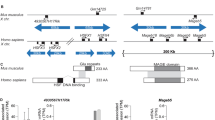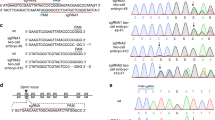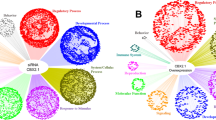Abstract
Steroid sulphatase (STS) Is an important enzyme in steroid metabolism1. The human STS gene has been cloned and mapped to Xp22.3, proximal to the pseudoautosomal region (PAR)2. Using quantitative differences in STS activity among various mouse strains, a segregation pattern consistent with autosomal linkage was first reported3–5, but more recent studies have linked Ste to the mouse PAR6–11. Failed attempts to clone the mouse Sfs gene using human reagents (STS cDNA and anti-STS antibodies) suggest a substantial divergence between these genes. However, partial amino-terminal sequence from purified rat liver Sts is very similar to its human counterpart12, and several domains are conserved among all the sulphatases13–14. We followed a degenerate-primer reverse transcriptase-PCR (RT-PCR) approach to amplify a conserved fragment of the rat Ste cDNA that was then used to clone the mouse Ste cDNA. This 2.3-kb cDNA revealed 75% similarity with rat Sfs cDNA, while it was only 63% similar to human STS cDNA. Transfection of STS(−) A9 cells with the mouse Sfs cDNA restored STS enzymatic activity. Sts was also mapped physically to the distal end of the mouse sex chromosomes, and our backcross studies placed Sts distal to the ‘obligatory’ crossover in male meiosis.
This is a preview of subscription content, access via your institution
Access options
Subscribe to this journal
Receive 12 print issues and online access
$209.00 per year
only $17.42 per issue
Buy this article
- Purchase on Springer Link
- Instant access to full article PDF
Prices may be subject to local taxes which are calculated during checkout
Similar content being viewed by others

References
Ballabio, A. & Shapiro, L. Steroid sulfatase deficiency and X-linked ichthyosis. in The metabolic and molecular bases of inherited disease. (eds Scriver, C.R., Beaudet, A.L., Sly, W.S. & Valle, D.) 2999–3022 (McGraw-Hill, New York, 1995).
Yen, P.M. et al. Cloning and expression of steroid sulfatase cDNA and the frequent occurrence of deletions in STS deficiency: Implications for X-Y interchange. Cell 49, 443–454 (1987).
Keinanen, B.M., Nelson, K., Daniel, W.L. & Roque, J.M. Genetic analysis of murine arylsulfatase C and steroid sulfatase. Genetics 105, 191–206 (1983).
Erickson, R.P., Harper, K. & Kramer, J.M. Identification of an autosomal locus affecting steroid sulfatase activity among inbred strains of mice. Genetics 105, 181–189 (1983).
Balazs, I., Purrello, M., Rocchi, M., Rinaldi, A.&., Siniscalco, M. Is the gene for steroid sulfatase X-linked in man?An appraisal of the data from humans, mice, and their hybrids. Cytogenet. Cell Genet. 32, 251–252 (1982).
Gartler, S.M. & Rivest, M. Evidence for X-linkage of steroid sulfatse in the mouse: steroid sulfatase levels in oocytes of XX and XO mice. Genetics 103, 137–141 (1983).
Keitges, E., Rivest, M., Siniscalco, M. & Gartler, S.M. X-linkage of steroid sulfatase in the mouse is evidence for a functional Y-linked allele. Nature 315, 226–227 (1985).
Nagamine, C.M., Michot, J.L., Roberts, C., Guenet, J.L. & Bishop, C.E. Linkage of the murine steroid sulfatase locus, Sts, to the sex reversed, Sxr: a genetic and molecular analysis. Nucl. Acids Res. 15, 9227–9238 (1987).
Keitges, E.A., Schorderet, D.F. & Gartler, S.M. Linkage of the steroid sulfatase gene to the sex-reversed mutation in the mouse. Genetics 116, 465–468 (1987).
Soriano, P., Keitges, E.A., Schorderet, D.F., Harbers, K., Gartler, S.M. & Jaenisch, R. High rate of recombination and double crossovers in the mouse pseudoautosomal region during male meiosis. Proc. Natl. Acad. Sci. USA 84, 7218–7220 (1987).
Cattanach, B. & Crocker, M. X chromosomal location of Sts. Mouse News Lett. 74, 94–95 (1986).
Kawano, J. et al. Characterization of rat and human steriod sulfatases. Biochim. Biophys. Acta 997, 199–205 (1989).
Peters, C. et al. Phylogenetic conservation of arylsulfatases.Cloning and expression of human arylsulfatase B. J. Biol. Chem. 265, 3374–3381 (1990).
Grompe, M., Pieretti, M., Caskey, T. & Ballabio, A. The sulfatase gene family: cross-species PCR cloning using the MOPAC technique. Genomics 12 755–760 (1992).
Li, X.M. et al. Cloning of the rat steroid sulfatase gene (Sts), an X-linked gene outside the pseudoautosomal region which undergoes X inactivation. Mamm. Genome (in the press).
Yen, P.H. et al. The human X-linked steroid sulfatase gene and a Y-encoded pseudogene: evidence for an inversion of the Y chromosome during primate evolution. Cell 55, 1123–1135 (1988).
Lyon, M.F. Gene action in the X-chromosome of the mouse (Mus musculus L.). Nature 190, 372–373 (1961).
Salido, E.C., Passage, M.B., Yen, P.H., Shapiro, L.J. & Mohandas, T.K. An evaluation of the inactive mouse X chromosome in somatic cell hybrids. Somaf.Cell Mol. Genet. 19, 65–71 (1993).
Shapiro, L.J. Mohandas, T., Weiss, R. & Romeo, A. Non-inactivation of an X chromosome locus in man. Science 204, 1224–1226 (1979).
Ellis, N. & Goodfellow, P.N. The mammalian pseudoautosomal region. Trends Genet. 5, 406–410 (1989).
Rouyer, F. et al. A gradient of sex linkage in the pseudoautosomal region of the human sex chromosomes. Nature 319, 291–295 (1986).
Lau, E.G., Mohandas, T.K., Shapiro, L.J., Slavkin, H.C. & Snead, M.L. Human and mouse amelogenin gene loci are on the sex chromosomes. Genomics 10, 971–975 (1991).
Ohno, S. Sex chromosomes and sex-linked genes(Springer, Berlin, 1967).
Rappold, G.A. The pseudoautosomal regions of the human sex chromosomes. Hum. Genet. 92, 315–324 (1993).
Sambrook, J., Fritsch, E.F. and Maniatis, T. Molecular Cloning: a Laboratory Manual 2nd edn. (Cold Spring Harbor Laboratory Press, Cold Spring Harbor, 1989).
Mortaud, S., Donsez-Darcel, E., Roubertoux, P.L. & Degrelle, H. Murine steroid sulfatase (mSTS): purification, characterization and measurement by ELISA. J. Steroid Biochem. Mol. Biol. 52, 91–96 (1995).
Kumar, S., Tamura, K. & Nei, M. MEGA: molecular evolutionary genetics analysis, version 1.01, (Pennsylvania State University, Philadelphia, 1993).
Author information
Authors and Affiliations
Corresponding author
Rights and permissions
About this article
Cite this article
Salido, E., Li, X., Yen, P. et al. Cloning and expression of the mouse pseudoautosomal steroid sulphatase gene (Sts). Nat Genet 13, 83–86 (1996). https://doi.org/10.1038/ng0596-83
Received:
Accepted:
Issue Date:
DOI: https://doi.org/10.1038/ng0596-83
This article is cited by
-
A primer on the use of mouse models for identifying direct sex chromosome effects that cause sex differences in non-gonadal tissues
Biology of Sex Differences (2016)
-
A pronounced evolutionary shift of the pseudoautosomal region boundary in house mice
Mammalian Genome (2012)
-
Brain Pathways Mediating the Pro-Aggressive Effect of the Steroid Sulfatase (Sts) Gene
Behavior Genetics (2010)
-
CSF2RA, ANT3, and STS are autosomal in marsupials: implications for the origin of the pseudoautosomal region of mammalian sex chromosomes
Mammalian Genome (1998)
-
High frequency de novo alterations in the long–range genomic structure of the mouse pseudoautosomal region
Nature Genetics (1996)


